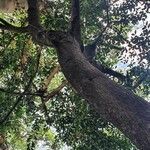Leaves spirally arranged, tending to be distichous, often subopposite; lamina narrowly obtriangular to subobovate, or oblong to elliptic, 3–8 x 2–4.5 cm., subcoriaceous; apex truncate to emarginate (bilobed) or obtuse; base acute to obtuse; margin entire; both surfaces glabrous; lateral veins 5–10 pairs, midrib not reaching the apex of the lamina, tertiary venation reticulate or tending to run parallel to the lateral veins; petiole 5–20 mm. long, 1–2 mm. thick; stipules c. 5 mm. long, glabrous or yellowish-whitish puberulous, subpersistent or caducous.
Small to medium tree, 5-10(-20) m high, strangler or rock-splitter. Bark creamish grey to light grey, smooth, with longitudinal fissures. Leaves spirally arranged, sometimes in one plane, leathery, glossy dark green, obovate to obtriangular (30-95 x 17-52 mm), hairless, base tapering, apex rounded to truncate; petioles 4-23 mm long. Syconia (figs) in pairs in leaf axils, without stalk, ± round, with a slight nipple, hairless, usually glossy, with creamy yellow spots.
A fig. It is a small tree. It grows 10 m tall. It can be partly attached to other plants. It can grow as a strangler. The leaves are almost opposite or in spirals and 3-9 cm long. They are dark green above and paler underneath. They are almost triangle shaped. The tip is blunt or has 2 lobes. The leaf stalk has a groove along the top. The fruit are figs 15 mm across. They are in pairs in the axils of leaves. They do not have stalks and are warty with red spots.
Medium-sized to large tree, up to 20 m high. Leaves short-stalked, lamina 40-80 x 20-30 mm, obovate-oblong or triangular-obovate, pointed to rounded or truncate to emarginate at apex. Figs paired in leaf axils, usually stalkless, roundish, up to 15 mm in diameter, yellow to red when ripe.
Figs in pairs in the leaf axils, sessile, initially enclosed in a calyptrate bud up to 1 cm. long which later splits into two subpersistent or caducous parts, pubescent inside; basal bracts 1–1.5 mm. long, persistent.
Receptacle globose to ellipsoid, 8–12 mm. in diam. when fresh, c. 5 mm. in diam. when dry, glabrous or puberulous, reddish (or yellowish) at maturity; wall slightly wrinkled when dry.
Leafy twigs 2–5 mm. thick, glabrous or white-puberulous to hirtellous, periderm sometimes flaking off when dry.
Tree up to 10 m. tall, or a shrub, hemi-epiphytic.




